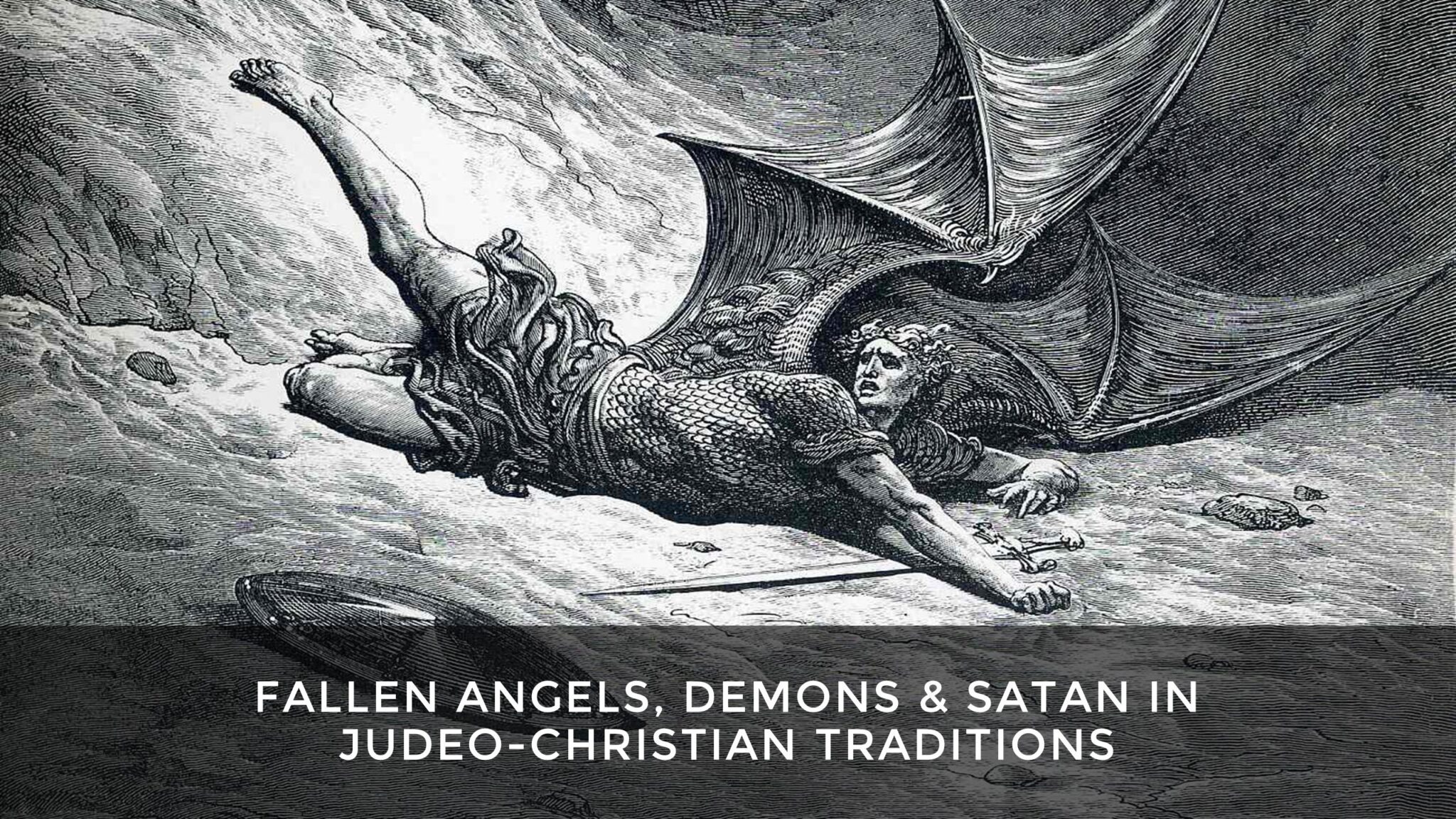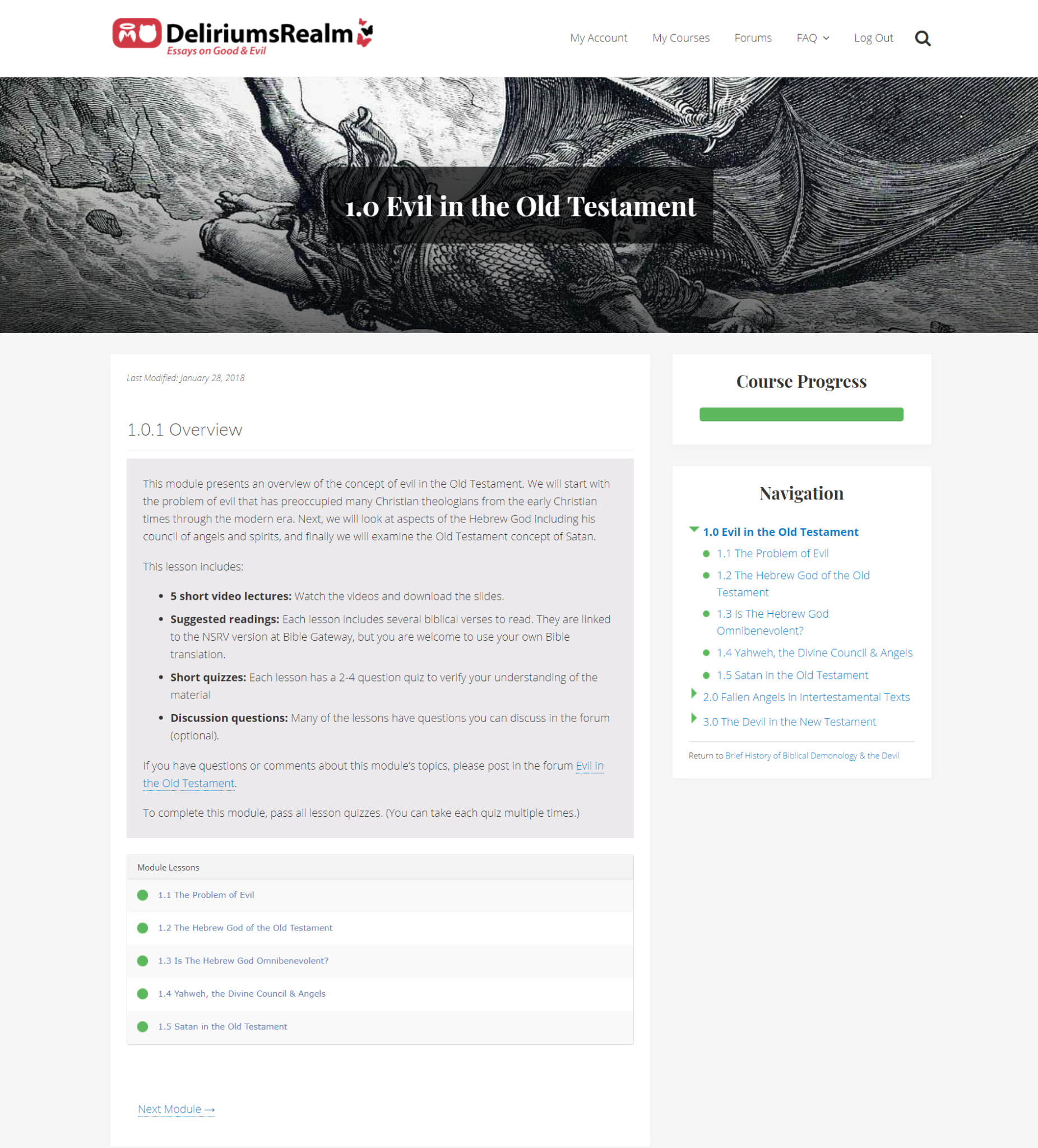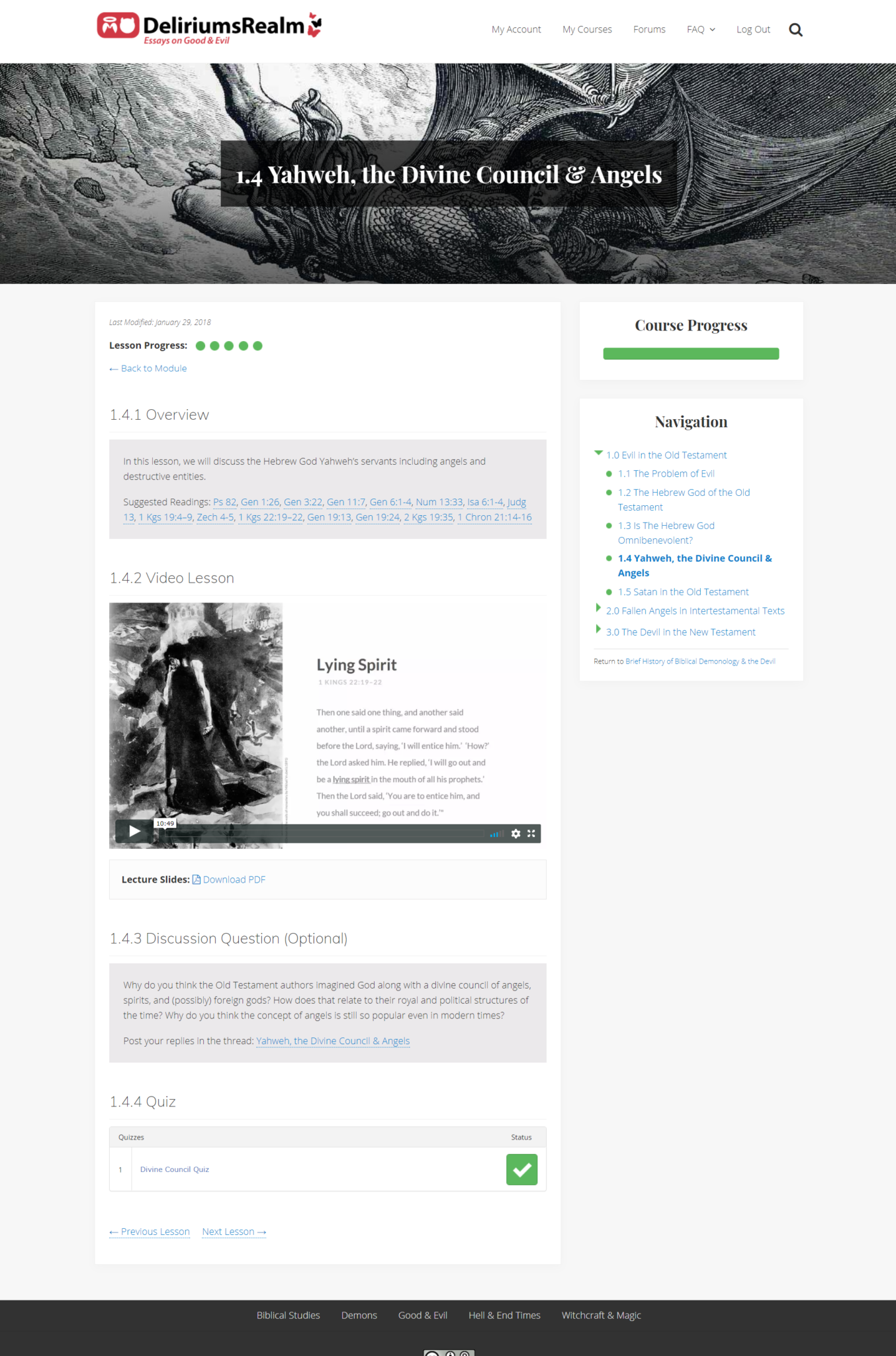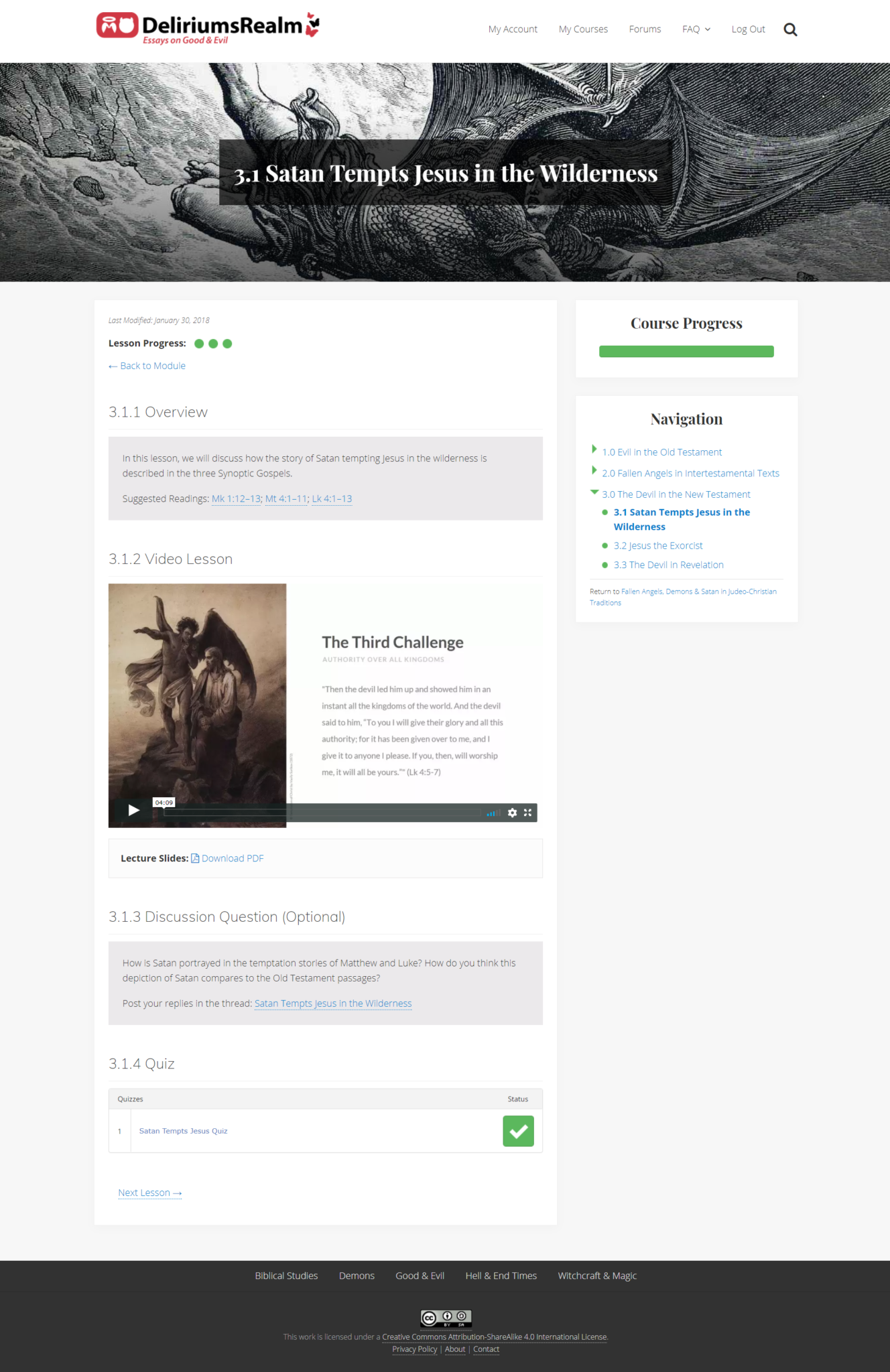Description
Course Includes:
- Enjoy 24/7 access to course materials and the course discussion forum.
- Learn from mobile-friendly content that adapts to your device and preferences.
- Access all updates to the course for a full year after enrollment.
- Trust our 30-day 100% money-back refund policy and our 365-day access guarantee.
Structure:
- Study at your own pace without any hard deadlines.
- Watch over 3 hours of video content with expert insights and explanations.
- Read suggested materials to deepen your understanding of biblical demonology.
- Discuss optional forum questions with peers.
- Test your knowledge and retention with short multiple-choice quizzes.
Who Should Take This Course?
Are you curious about what the Bible actually says about Satan and demons? Do you want to learn how the devil and his minions came to be? Do you wonder how ancient people dealt with evil and suffering in their world? If so, this course on biblical demonology is for you.
In this course, you will explore the origins and development of biblical demonology, the study of demons and the devil in the Bible, Judaism, and early Christianity. You will discover how these supernatural beings evolved from ancient myths to complex theological concepts.
This course is designed for beginners. No prior knowledge is required. All you need is an interest in religion, history, or mythology.
Enroll now and join over 330 students who have already completed this course and discovered the fascinating world of biblical demonology!
Biblical Demonology Course Syllabus
Module 1: Intro to The Devil & Origin of Evil
Lesson 1: What is a Demon? What is Demonology?
In this lesson, you will learn how demons and the Devil influence our modern culture and how to study demonology as a scholarly discipline. You will also explore the different types of demons and their roles in various religions and myths.
Lesson 2: The Problem of Evil
In this lesson, you will examine the philosophical questions that arise from the existence of evil and suffering in the world. You will also learn how different religious traditions try to explain and cope with evil.
Lesson 3: What is Theodicy?
In this lesson, you will learn what theodicy is and how it attempts to justify God’s goodness and power in the face of evil. You will also review some of the most popular Christian theodicies and their strengths and weaknesses.
Lesson 4: What is Apocalypticism?
In this lesson, you will learn what apocalypticism is and how it shapes the worldview of many religious groups. You will also discover how apocalypticism gave rise to the concept of the Devil as a personified evil being who opposes God and his people.
Lesson 5: How To Study Religious Beliefs Historically
In this lesson, you will learn the historical-critical method of analyzing religious texts and traditions. You will understand how the historical context of a text influences its meaning and interpretation. You will also discover how to compare and contrast different religious beliefs and practices in their historical development. This lesson will equip you with the skills and tools to study religion as a historical phenomenon.
Module 2: The Combat Myth: Storm Gods & Sea Dragons
Lesson 6: The Combat Myth: An Overview
Discover the common elements of the Combat Myth, a popular theme in ancient Near Eastern literature that involves a battle between two divine beings. Learn how this myth reflects the worldview and values of ancient cultures.
Lesson 7: Ninurta vs Anzu
Explore one of the earliest examples of the Combat Myth, the story of Anzu, a bird-like creature who steals the king’s powers from Enlil, the supreme god. Find out how Ninurta, the warrior god, defeats Anzu and restores order.
Lesson 8: Enuma Elish: Marduk vs Tiamat
Dive into the Babylonian Epic of Creation, Enuma Elish, which tells how Marduk, the patron god of Babylon, defeats Tiamat, the primordial chaos monster, and creates the world. See how this myth legitimizes Marduk’s kingship and Babylon’s supremacy.
Lesson 9: Ugaritic Baal Cycle
Examine the Ugaritic Baal Cycle, a Canaanite story that describes how Baal, the god of storm and fertility, defeats Yamm, the god of sea, and Mot, the god of death, and becomes king of the gods. Learn how this myth reflects the seasonal cycle of nature and agriculture.
Lesson 10: Old Testament Dragons, Leviathan & Rahab
Compare the references to Yahweh’s combat with various enemies in the Old Testament, such as the Sea, dragons (”tanninim”), or dragon-like creatures like Rahab or Leviathan. Understand how Yahweh is portrayed as a warrior god who establishes his sovereignty over creation.
Module 3: Evil in the Old Testament
Lesson 11: The Hebrew God of the Old Testament
Learn how the Old Testament portrays the Hebrew God and his relation to foreign gods. Discover how the biblical writers understood the nature and existence of other deities.
Lesson 12: Is the Hebrew God Yahweh Omnibenevolent?
Explore the paradox of God’s goodness and power in the face of evil and suffering. Examine how the Old Testament depicts God as the source of both blessing and calamity.
Lesson 13: Yahweh, the Divine Council & Angels
Dive into the heavenly realm of Yahweh and his divine council. Find out who are the angels, sons of God, spirits, and other supernatural beings that serve Yahweh and interact with humans
Lesson 14: Satan in the Old Testament
Meet Satan, the Adversary or Accuser of Yahweh’s divine council. Learn how Satan challenges Yahweh’s authority and justice in several Old Testament stories.
Module 4: Demons & Fallen Angels in Intertestamental Texts
Lesson 15: Dead Sea Scrolls: A Brief History
Learn about the Dead Sea Scrolls, a collection of ancient Jewish manuscripts that shed light on the origins of biblical demonology. Find out how they were discovered, what they contain, and why they are important.
Lesson 16: Asmodeus in the Book of Tobit
Meet Asmodeus, the first named demon in Jewish literature. Discover how he torments a young couple in the Book of Tobit, an apocryphal story from the 3rd century BCE. See how he is exorcised by the angel Raphael.
Lesson 17: Fallen Angels/Watchers in 1 Enoch
Explore the legend of the Watchers, a group of rebel angels who sinned with human women and produced giants. Learn how this story is told in 1 Enoch, an influential Jewish book from the 2nd century BCE. Understand how this legend influenced later views of Satan and demons.
Lesson 18: The Demonology of Jubilees
Compare the demonology of Jubilees, another Jewish book from the 2nd century BCE, with that of 1 Enoch. Learn how Jubilees explains the origin of evil spirits, their relation to the Watchers, and their role in human history.
Lesson 19: The War Scroll: Michael vs Belial
Witness the cosmic battle between good and evil in the War Scroll, a document found among the Dead Sea Scrolls. Learn how Belial, the leader of the forces of darkness, is opposed by Michael, the prince of light. See how this war will end with God’s intervention and judgment.
Lesson 20: The Two Spirits in The Community Rule
Examine the ethical teachings of the Community Rule, another document found among the Dead Sea Scrolls. Learn how this text describes two spirits that influence human behavior: the spirit of truth and the spirit of falsehood. Understand how this text defines who is righteous and who is wicked.
Module 5: The Devil in the New Testament
Lesson 21: Satan Tempts Jesus in the Wilderness
Learn how Satan tries to test Jesus’s faith and identity in three different ways. Compare how Matthew and Luke tell this story and what it reveals about their views of Satan and Jesus.
Lesson 22: Jesus the Exorcist
Discover how Jesus demonstrates his authority and power over demons in five exorcism stories. Analyze the symptoms, methods, and outcomes of each case and what they say about Jesus’s mission and message.
Lesson 23: The Devil in Revelation
Explore the most vivid and detailed depiction of Satan in the Bible. See how Satan is identified as the Great Red Dragon, the leader of the rebel angels, and the mastermind behind the two beasts and the number 666. Understand how Satan’s final defeat by Christ and his angels fulfills God’s plan for history.




